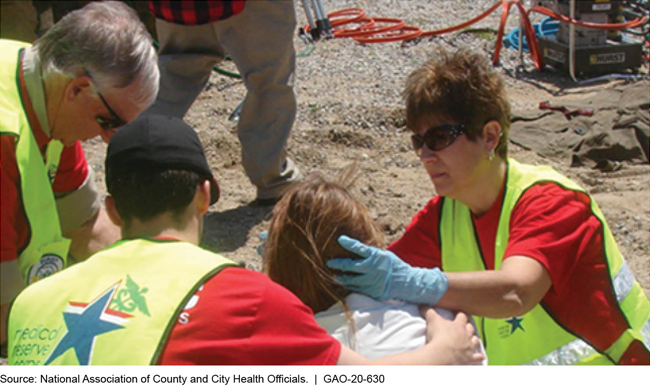Public Health Preparedness: Information on the Use of Medical Reserve Corps Volunteers during Emergencies
Fast Facts
Physicians, nurses, and other providers can volunteer in their communities to help people affected by public health emergencies. These volunteers, known as the Medical Reserve Corps, provide first aid and shelter support during a variety of events—like wildfires, hurricanes, and pandemics—and provided medical aid to migrants at the southern border. They have also assisted with drive-thru testing during the COVID-19 pandemic.
The Department of Health and Human Services has provided the Medical Reserve Corps with resources on how to recruit and retain volunteers, which is critical to states' preparedness for public health emergencies.
Medical Reserve Corps Volunteers Assist during an Emergency Exercise

Highlights
What GAO Found
Almost all states have a network of health care volunteers—the Medical Reserve Corps—who can augment federal, state, and local capabilities in response to public health emergencies, such as those arising from wildfires and hurricanes, and infectious disease outbreaks. Having sufficient, trained personnel, such as these volunteers, is critical to a state's capability to respond and recover from public health emergencies. According to federal data, 48 states and the District of Columbia reported 102,767 health care volunteers in 838 Medical Reserve Corps units as of September 2019, with nurses making up 43 percent.
Number of Medical Reserve Corps Volunteers by Type, as of September 2019

Note: These data illustrate 90 percent of total health care volunteers. The remaining five types volunteers each make up less than 5 percent of the total. Other Public Health Medical volunteers may include cardiovascular technicians, sonographers, and phlebotomists.
Medical Reserve Corps volunteers in states included in GAO's review—Alabama, California, North Carolina, and New Mexico—were deployed in response to natural disasters in 2018 and 2019, migrants at the southern border in 2019, and COVID-19 in 2020. Department of Health and Human Services (HHS) documentation shows these volunteers performed a variety of health care activities, such as providing medical services, setting up and providing support at shelters, and distributing medical supplies. Volunteers from these four states and others also participated in the response to COVID-19 by supporting testing sites, collecting specimens, and performing administrative tasks, such as data entry. For example, one unit deployed four volunteers a day for 3 days to work alongside nurses at a drive-through testing site. In addition to responding to public health emergencies, volunteers participated in preparedness activities, such as an initiative to train the public on how to respond to emergencies.
HHS oversees the Medical Reserve Corps program and has assisted units in developing their volunteer capabilities. For example, HHS
- funded the development of a checklist of activities that should occur during volunteer deployment such as re-verifying medical credentials;
- provided training to new unit leaders on developing, managing, and sustaining Medical Reserve Corps units; and
- issued generally accepted practices, such as periodically re-evaluating volunteer recruitment procedures.
Why GAO Did This Study
The Medical Reserve Corps consists of health care volunteers—medical and public health professionals—who donate their time to help strengthen a response to public health emergencies and build community resilience. These volunteers prepare for and respond to public health emergencies, which may include natural disasters—such as hurricanes and wildfires—as well as disease outbreaks, whether intentional or natural.
The Pandemic and All-Hazards Preparedness and Advancing Innovation Act of 2019 included a provision for GAO to review states' use of health care volunteers during public health emergencies. This report describes (1) the number and type of Medical Reserve Corps volunteers; (2) the types of public health emergencies volunteers have participated in; and (3) how HHS has assisted in developing volunteer capabilities.
To conduct this work, GAO analyzed data reported to HHS as of September 2019; reviewed HHS documentation on four states' use of volunteers, which GAO selected based on population, number of volunteers, and event; and interviewed officials from HHS who oversee the Medical Reserve Corps program.
GAO plans to further examine how states have used health care volunteers to respond to public health emergencies, including COVID-19, and any associated challenges to doing so in a future report.
GAO provided a draft of this report to HHS. In response, HHS provided technical comments, which were incorporated as appropriate.
For more information, contact Mary Denigan-Macauley at (202) 512-7114 or deniganmacauleym@gao.gov.
